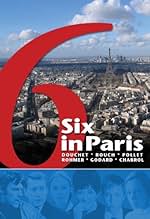Füge eine Handlung in deiner Sprache hinzuSix vignettes set in different sections of Paris, by six directors. St. Germain des Pres (Douchet), Gare du Nord (Rouch), Rue St. Denis (Pollet), and Montparnasse et Levallois (Godard) are s... Alles lesenSix vignettes set in different sections of Paris, by six directors. St. Germain des Pres (Douchet), Gare du Nord (Rouch), Rue St. Denis (Pollet), and Montparnasse et Levallois (Godard) are stories of love, flirtation and prostitution; Place d'Etoile (Rohmer) concerns a haberdashe... Alles lesenSix vignettes set in different sections of Paris, by six directors. St. Germain des Pres (Douchet), Gare du Nord (Rouch), Rue St. Denis (Pollet), and Montparnasse et Levallois (Godard) are stories of love, flirtation and prostitution; Place d'Etoile (Rohmer) concerns a haberdasher and his umbrella; and La Muette (Chabrol), a bourgeois family and earplugs.
- Auszeichnungen
- 1 Nominierung insgesamt
Empfohlene Bewertungen
Some of the names here are bigger than others. Godard is the biggest, with Chabrol probably the next in line. How big any were at the time I don't know, but now (2016) this makes for a nice sampler of different styles in what is called the New Wave. Tales of Paris seem very appropriate, and almost anticipate later films where New York is very much a subject.
Douchet's tale, set in Saint-Germain-des-Prés, offers light comedy-drama as a young woman learns the hard way about the pig-headed behavior of men looking for a one-night stand. Rouch's story, in Gare du Nord, is a domestic drama in miniature as a young couple argue, with underlying themes of dreams and aspirations versus the reality that later sets in. Pollet and Rohmer, more or less showcasing Rue Saint-Denis and Place de l'Etoile respectively, serve up light comedy, which as the film presents is a welcome palate cleanser after the heavier nature of Rouch's vignette. I'm particularly fond of Rohmer's short as his approach here very much recalls the ethos of silent movies, even including intertitles for some slight exposition. Lastly, we're given two tales that seem most primed to be full-length pictures all by themselves: Godard's, set in Montparnasse-Levallois, tells of a woman who sends telegrams expressing love to two different men but realizes she sent each to the wrong address; Chabrol's, instead simply called "La muette," closes the length with the most severe drama of all, with a household in which the parents argue and their unattended school-age son makes mischief before just shutting out the noise entirely.
Taken as a whole it's entertainment of a more modest nature that 'Paris vu par...' gives us. A couple of these segments might strike more of a chord as they come and go (Rouch's and Chabrol's, in my opinion), but not necessarily all six, though one way or another each is enjoyable in its way. Still, the cast do a fine job across the board, each segment is as well made as it is smartly written, and these ninety-five minutes pass surprisingly quickly. Unless one is a huge fan of someone involved I don't think it's anything one needs to go out of their way to see, but it's worthwhile on its own merits, and best suggested for a quiet day when you're looking for something to watch that doesn't completely require active investment.
Wusstest du schon
- WissenswertesThis was the first French feature shot entirely in 16mm and then blown up for release in 35mm.
- VerbindungenFollowed by Paris vu par... 20 ans après (1984)
Top-Auswahl
- How long is Six in Paris?Powered by Alexa
Details
- Erscheinungsdatum
- Herkunftsland
- Sprache
- Auch bekannt als
- Six in Paris
- Drehorte
- Paris, Frankreich(segment "La Muette")
- Produktionsfirmen
- Weitere beteiligte Unternehmen bei IMDbPro anzeigen
Box Office
- Bruttoertrag in den USA und Kanada
- 15.532 $
- Eröffnungswochenende in den USA und in Kanada
- 4.053 $
- 5. Okt. 2008
- Weltweiter Bruttoertrag
- 15.532 $
Zu dieser Seite beitragen

























